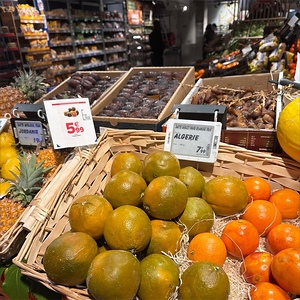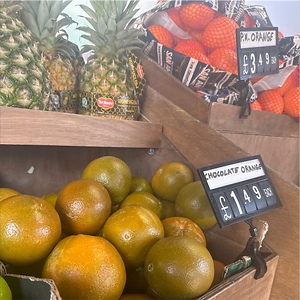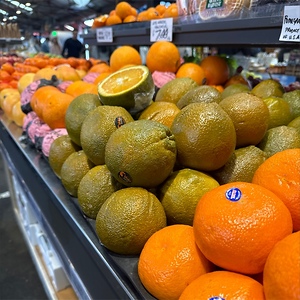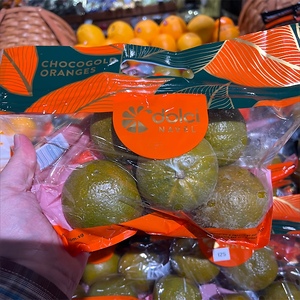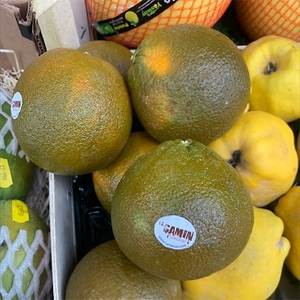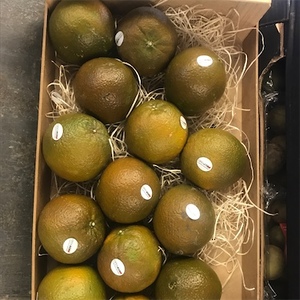

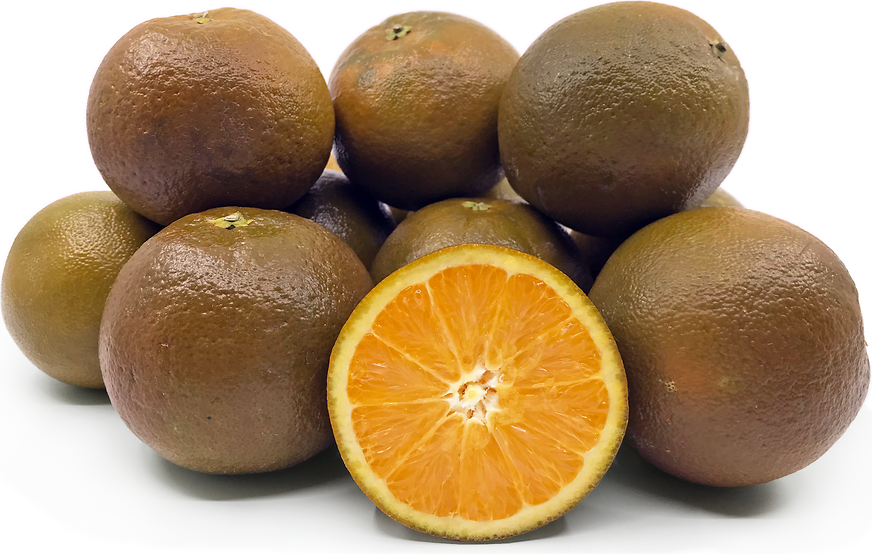
Navel Chocolate Oranges
Estimated Inventory, lb : 0
Description/Taste
Navel Chocolate oranges are a medium to large varietal, averaging 6 to 10 centimeters in diameter, and have a round to oval shape with a curved, uniform appearance. The oranges have a characteristic "navel" or circular hole on the blossom stem end. This small opening is created from a genetic mutation within the variety that causes a secondary orange, known as the twin fruit, to grow within the orange. This secondary fruit never fully develops but creates a hole that resembles a human navel or belly button, giving the variety its navel moniker. Navel Chocolate oranges have a thin, easy-to-peel rind with a glossy, smooth, and pebbled appearance, a texture created from the prominence of sunken oil glands, creating small bumps on the surface. The oranges also develop a distinct brown hue from the presence of multiple pigments within the skin. Navel Chocolate oranges ripen from green to variegated orange, brown, and green hues. There is also a slender, bright orange stripe that sometimes appears, extending lengthwise along the fruit. Underneath the rind, a thin layer of white to pale orange pith is adhered to the flesh but is relatively easy to remove and has a spongy, dry consistency. The bright orange flesh is divided into 10 to 11 segments by thin membranes and is seedless with a tender, aqueous, soft, and succulent texture. Navel Chocolate oranges are aromatic and release sweet, fruity, and floral notes when peeled. The flesh is known for its high sugar content, reaching 12 Brix, mixed with low acidity, creating a mild, sugary-sweet, and neutral flavor.
Seasons/Availability
Navel Chocolate oranges are available for a limited season in the winter through early spring.
Current Facts
Navel Chocolate oranges, botanically classified as Citrus sinensis, are a rare type of Navel orange belonging to the Rutaceae family. The variety grows on compact, evergreen trees and was discovered growing as a natural mutation on a navel orange tree in Valencia, Spain. Navel Chocolate oranges were selected for their unusual rind coloring and sweet, low acidity flavor, known as the sweetest cultivar of the navel varieties. The oranges are also sometimes called Chocolate Navel oranges and are a specialty fruit produced on a small scale by a few growers in Valencia. The trees are sensitive to weather conditions and are low producers, only developing a limited number of fruits each season. Despite their challenging cultivation requirements, Navel Chocolate oranges are sold as a premium novelty and are utilized in a wide array of fresh and cooked preparations. In Europe, Navel Chocolate oranges have become a popular specialty gift during Christmas. The uniquely colored fruits are only found in markets during the winter, and the tradition of gifting oranges symbolizes sharing blessings and good health with others dating back to the Middle Ages.
Nutritional Value
Navel Chocolate oranges are a source of fiber to regulate the digestive tract, potassium to balance fluid levels within the body, and vitamin C to strengthen the immune system while reducing inflammation. The oranges also provide calcium to build strong bones and teeth, vitamin A to maintain healthy organ functioning, folate to develop DNA and RNA, vitamin E to protect the cells against free radical damage, copper to produce connective tissues, and other nutrients, including magnesium, phosphorus, manganese, zinc, and B vitamins.
Applications
Navel Chocolate oranges have a mild and sweet taste suited for fresh and cooked preparations. The oranges are primarily consumed raw to savor their juicy nature and colorful rind, and the flesh can be segmented and tossed into salads, used as a topping over breakfast dishes such as parfaits and oats, or mixed into fruit medleys. Navel Chocolate oranges can be used in any recipe calling for standard navel oranges, and the flesh is popularly chopped into dips and spreads, added to salsa, used as a garnish over cooked meats, or segmented and dipped into chocolate as a snack. Try placing orange slices over toast with soft cheese or serve the oranges with the rind still attached on charcuterie boards. In addition to fresh preparations, Navel Chocolate oranges can be simmered into jams, jellies, and marmalades, and pure cocoa powder can be mixed into the marmalade as a unique variation. The oranges can also be zested and juiced to flavor cakes, scones, cookies, and other baked goods or cooked into syrups. The rind can be dried and ground into salts and sugars, cooked into sauces for meats, or roasted to create a layer of caramelization and served with cinnamon as a dessert. Navel Chocolate oranges pair well with nuts such as pistachios, pecans, almonds, and pine, fruits including strawberries, bananas, coconut, and pomegranate seeds, cucumber, herbs such as cilantro, parsley, and rosemary, seafood including shrimp, fish, and scallops, and meats such as poultry, pork, and steak. Whole, unwashed Navel Chocolate oranges will keep up to a week at room temperature and up to two weeks when stored in the refrigerator's crisper drawer.
Ethnic/Cultural Info
Navel Chocolate oranges received their sugary-sweet moniker for their brown rind coloring. Despite their name, Navel Chocolate oranges do not taste like chocolate. The orange's brown hue is created from a mutation, where green pigments remain in the rind as the fruit matures, eventually mixing with orange pigments to create brown. Each orange has a different mix of green and orange pigments, giving the fruits unique, variegated coloring. Before they were named Chocolate, the navel orange variety was initially known as Black Navel oranges or Negra Navel. According to agronomists at the Valencian Institute of Agricultural Research, Black Navel oranges are a very old variety that has faded into obscurity in commercial orchards. The cultivar was mostly forgotten, but in the past few decades, a small number of growers in Spain are reviving the variety as a specialty navel. With the increase in production, growers decided that Black Navel oranges should be rebranded to Navel Chocolate oranges for increased consumer appeal. The chocolate moniker showcased the orange's sweet, sugary flavor and was more of a food-related name than Black Navel.
Geography/History
Navel Chocolate oranges are a natural mutation of the standard navel orange. Experts believe Navel Chocolate oranges are the same variety as Black Navel oranges, an older variety in Spain that was once cultivated but was eventually lost over time. The variety was rediscovered growing in a navel orange orchard in Picassent, a municipality in the comarca of Horta Sud in Valencia, Spain, in 2006. The tree bore variegated brown oranges, while all the surrounding trees were laden with orange fruits. After their discovery, the grower sent the brown-hued oranges to scientists, and it was found that Navel Chocolate oranges had a higher Brix level than standard orange navels. Navel Chocolate oranges also contain high juice levels, low acidity, and a longer shelf life. The variety was grafted and propagated on a small scale as a new cultivar for export. Wilkofruit, a Netherlands-based company, was the first business to export Navel Chocolate oranges. Since 2021, it has been reported that there are only around three Navel Chocolate orange growers in Spain, and the variety is seasonally sold domestically in Spain and exported to select countries worldwide.



